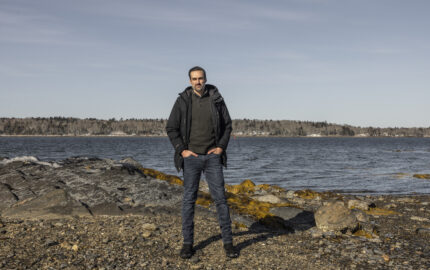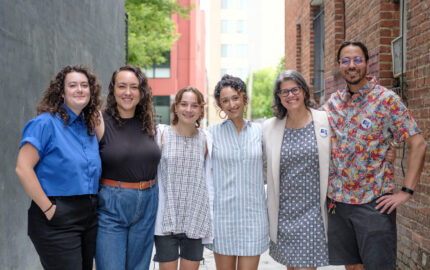“Unique local content” is by now a familiar phrase as print competes with digital media for readers’ attention. With constantly updated international and national news reporting and commentary just a click away, hometown readers need different reasons to go to their local newspaper, in print or online. In this issue of Nieman Reports, we will explore what local news reporting can look like and what a hometown focus can mean for journalists, newspapers, Web sites, and those who consume this news and information.
Brett J. Blackledge, a reporter at The Birmingham News, won the 2007 Pulitzer Prize for Investigative Reporting for a story he began telling about a small, local college that trained firefighters. For two years, he followed the trail of corruption and cronyism he found within the state’s two-year college system. “Newspapers have one place among the increasingly crowding media as the ever-vigilant watchdog, and it’s what we do best for local audiences” he writes. In Seattle, Ken Armstrong, a reporter at The Seattle Times, won ASNE’s 2007 Local Accountability Reporting award for a series of stories about improperly sealed lawsuits in the county’s superior court. “We could have gone broad—writing about sealed records on a national level …. Or we could have gone local …” he writes. “National offered scale. Local offered depth. We decided to go local.”
Two bureau reporters at The Times Herald-Record in Middletown, New York, John Doherty and Tim Logan, set out to portray in-depth the demise of a nearby “small, poor, violent, old factory town.” The result was a controversial collection of stories that, as they write, “dispensed with the usual back-and-forth balancing between sides.”
At The Post and Courier in Charleston, South Carolina, going local meant sending a reporter, Tony Bartelme, and a photographer, Alan Hawes, to China to send back word about a Charleston resident’s stem cell transplant. While there, they found other “local” stories about business connections. In words and images, they describe their trip. As environmental reporter at The Des Moines Register, Perry Beeman creates searchable databases using local information so readers can see for themselves how climate change, pollution and industry are affecting them. “… for every national and global story, a local angle is waiting to be told,” he says. At WISH-TV in Indianapolis, Indiana, a Peabody Award-winning investigation into inadequate helmet protection for the military in Iraq had many local dimensions. As news director Kevin Finch writes, “Local means local, even when the story originates half a world away.”
At The Dallas Morning News, assistant editorial page editor Michael Landauer recruits volunteer columnists to be “Community Voices,” and their words are published on zoned local pages in the paper’s Metro section. “The person needs to think locally, write well, tell us something we don’t know, and be persuasive,” he says. In Albany, New York, Times Union Editor Rex Smith pushes breaking local news to the newspaper’s Web site and expects his newsroom to do more analysis of news and aggressive in-depth local reporting, which in his city includes state government and politics. “Throughout our newspaper,” he writes, “content is relentlessly local.”
Will Bunch, who blogs and writes for the Philadelphia Daily News, knows why this push for local coverage is happening but realizes that “not one of us wanted to be covering local news at our age (or, for that matter, at any age).” As editor of The Roanoke Times, Carole Tarrant echoes Bunch’s concern: “How do we resolve the tensions we all know exist between what the news organization needs and the ambitions of those who will be sent out on the frontlines?” Thomas E. Patterson, acting director of the Shorenstein Center on the Press, Politics and Public Policy, reports on the findings from three studies about local newspapers “and how the Internet is changing the distribution of local news.” Rick Edmonds, media business analyst at the Poynter Institute, examines various news organizations’ “local-local” strategies, including local zoning efforts taking place at metro papers. Bill Ostendorf, president of Creative Circle Media Consulting, says the Web should have taught newspapers that “readers want the news to be about them; to speak to them; to address their questions and concerns directly.”
Dean Miller, executive editor of The Post Register in Idaho Falls, Idaho, speaks with Mary Nesbitt, managing director of Northwestern University’s Readership Institute, about studies she’s done about newspaper readers and the future of local news coverage. Lane DeGregory, a feature writer with the St. Petersburg Times, shared tips—ignore important people, read the walls, make freaky friends—for finding intriguing local stories with community journalists at a Nieman Foundation conference, and we provide excerpts from her talk.
Shawn McIntosh, director of culture and change at the Atlanta Journal-Constitution, and Rene Sanchez, deputy managing editor for news content at the Star Tribune, each write about organizational changes in the newsroom to accommodate a shift to local emphasis. At The Washington Post and the Chicago Tribune, hyperlocal coverage is now part of the newspaper’s online offerings to readers. At the Post’s LoudounExtra.com, according to one of its creators, Rob Curley, “relevance and relationship are at its core.” As managing editor of TribLocal.com, Kyle Leonard relies on “people who live in these communities to report a significant amount of the news.”
Jan Schaffer, executive director of J-Lab at the University of Maryland, provides key findings from a recent study about “the rise of local news sites based on user-generated content” and tips about launching a hyperlocal Web site. Geoff Dougherty, who had been an investigative reporter with the Chicago Tribune, is now editor of the online Chi-Town Daily News, which uses beat-reporting interns and neighborhood correspondents to be “relentlessly local.” Liz George, a New York Daily News editor and managing editor and co-owner of Baristanet.com, a hyperlocal online news site in New Jersey, writes that “zeroing in on readership by creating unique local content in a variety of forms is what we do at Baristanet.” Mark Potts, a cofounder of Backfence.com, a hyperlocal site that closed earlier this year for business reasons, describes how citizen journalism “augments and extends” professional journalism by covering news “that journalists can’t get to and by giving ‘audience’ members a voice.” At VillageSoup.com, a hyperlocal site serving two counties in MidCoast Maine, cofounder Richard M. Anderson finds his community host model combining exclusively local “professional, amateur and business content is proving to be successful.” Lisa Williams, founder of Placeblogger, the largest site of local Weblogs, and of h2otown, a hyperlocal site in Watertown, Massachusetts, compares what happened to high-tech workers during that industry’s downturn with what journalists are facing today as newsrooms shrink and jobs change. “What we discovered, of course, was that innovation survived the death of its institutions,” she writes.
Brett J. Blackledge, a reporter at The Birmingham News, won the 2007 Pulitzer Prize for Investigative Reporting for a story he began telling about a small, local college that trained firefighters. For two years, he followed the trail of corruption and cronyism he found within the state’s two-year college system. “Newspapers have one place among the increasingly crowding media as the ever-vigilant watchdog, and it’s what we do best for local audiences” he writes. In Seattle, Ken Armstrong, a reporter at The Seattle Times, won ASNE’s 2007 Local Accountability Reporting award for a series of stories about improperly sealed lawsuits in the county’s superior court. “We could have gone broad—writing about sealed records on a national level …. Or we could have gone local …” he writes. “National offered scale. Local offered depth. We decided to go local.”
Two bureau reporters at The Times Herald-Record in Middletown, New York, John Doherty and Tim Logan, set out to portray in-depth the demise of a nearby “small, poor, violent, old factory town.” The result was a controversial collection of stories that, as they write, “dispensed with the usual back-and-forth balancing between sides.”
At The Post and Courier in Charleston, South Carolina, going local meant sending a reporter, Tony Bartelme, and a photographer, Alan Hawes, to China to send back word about a Charleston resident’s stem cell transplant. While there, they found other “local” stories about business connections. In words and images, they describe their trip. As environmental reporter at The Des Moines Register, Perry Beeman creates searchable databases using local information so readers can see for themselves how climate change, pollution and industry are affecting them. “… for every national and global story, a local angle is waiting to be told,” he says. At WISH-TV in Indianapolis, Indiana, a Peabody Award-winning investigation into inadequate helmet protection for the military in Iraq had many local dimensions. As news director Kevin Finch writes, “Local means local, even when the story originates half a world away.”
At The Dallas Morning News, assistant editorial page editor Michael Landauer recruits volunteer columnists to be “Community Voices,” and their words are published on zoned local pages in the paper’s Metro section. “The person needs to think locally, write well, tell us something we don’t know, and be persuasive,” he says. In Albany, New York, Times Union Editor Rex Smith pushes breaking local news to the newspaper’s Web site and expects his newsroom to do more analysis of news and aggressive in-depth local reporting, which in his city includes state government and politics. “Throughout our newspaper,” he writes, “content is relentlessly local.”
Will Bunch, who blogs and writes for the Philadelphia Daily News, knows why this push for local coverage is happening but realizes that “not one of us wanted to be covering local news at our age (or, for that matter, at any age).” As editor of The Roanoke Times, Carole Tarrant echoes Bunch’s concern: “How do we resolve the tensions we all know exist between what the news organization needs and the ambitions of those who will be sent out on the frontlines?” Thomas E. Patterson, acting director of the Shorenstein Center on the Press, Politics and Public Policy, reports on the findings from three studies about local newspapers “and how the Internet is changing the distribution of local news.” Rick Edmonds, media business analyst at the Poynter Institute, examines various news organizations’ “local-local” strategies, including local zoning efforts taking place at metro papers. Bill Ostendorf, president of Creative Circle Media Consulting, says the Web should have taught newspapers that “readers want the news to be about them; to speak to them; to address their questions and concerns directly.”
Dean Miller, executive editor of The Post Register in Idaho Falls, Idaho, speaks with Mary Nesbitt, managing director of Northwestern University’s Readership Institute, about studies she’s done about newspaper readers and the future of local news coverage. Lane DeGregory, a feature writer with the St. Petersburg Times, shared tips—ignore important people, read the walls, make freaky friends—for finding intriguing local stories with community journalists at a Nieman Foundation conference, and we provide excerpts from her talk.
Shawn McIntosh, director of culture and change at the Atlanta Journal-Constitution, and Rene Sanchez, deputy managing editor for news content at the Star Tribune, each write about organizational changes in the newsroom to accommodate a shift to local emphasis. At The Washington Post and the Chicago Tribune, hyperlocal coverage is now part of the newspaper’s online offerings to readers. At the Post’s LoudounExtra.com, according to one of its creators, Rob Curley, “relevance and relationship are at its core.” As managing editor of TribLocal.com, Kyle Leonard relies on “people who live in these communities to report a significant amount of the news.”
Jan Schaffer, executive director of J-Lab at the University of Maryland, provides key findings from a recent study about “the rise of local news sites based on user-generated content” and tips about launching a hyperlocal Web site. Geoff Dougherty, who had been an investigative reporter with the Chicago Tribune, is now editor of the online Chi-Town Daily News, which uses beat-reporting interns and neighborhood correspondents to be “relentlessly local.” Liz George, a New York Daily News editor and managing editor and co-owner of Baristanet.com, a hyperlocal online news site in New Jersey, writes that “zeroing in on readership by creating unique local content in a variety of forms is what we do at Baristanet.” Mark Potts, a cofounder of Backfence.com, a hyperlocal site that closed earlier this year for business reasons, describes how citizen journalism “augments and extends” professional journalism by covering news “that journalists can’t get to and by giving ‘audience’ members a voice.” At VillageSoup.com, a hyperlocal site serving two counties in MidCoast Maine, cofounder Richard M. Anderson finds his community host model combining exclusively local “professional, amateur and business content is proving to be successful.” Lisa Williams, founder of Placeblogger, the largest site of local Weblogs, and of h2otown, a hyperlocal site in Watertown, Massachusetts, compares what happened to high-tech workers during that industry’s downturn with what journalists are facing today as newsrooms shrink and jobs change. “What we discovered, of course, was that innovation survived the death of its institutions,” she writes.



